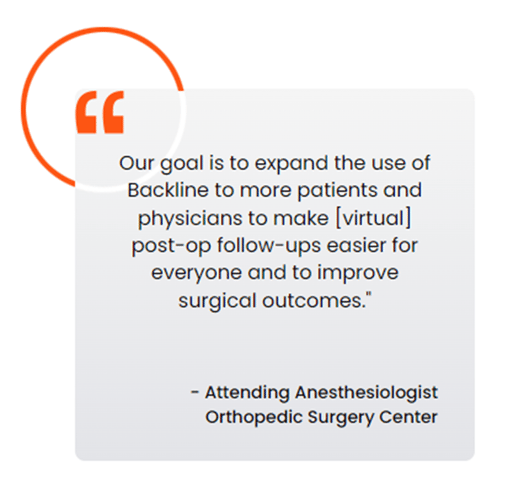The Benefits of Telehealth in Reducing Clinician Burden and Increasing Patient Engagement

The world of healthcare is constantly evolving, and one of the most impactful changes in recent years is the continued advancement and growing adoption of telehealth technologies. Telehealth is the delivery of healthcare services through digital communication channels, primarily video, allowing clinicians to connect with patients and each other remotely.
With increased adoption, telehealth continues to offer a wide range of benefits for clinicians, providing an option for expanding the reach and flexibility of providing care across increasingly complex patient panels while simultaneously supporting patient engagement.
In this blog post, we will explore how the use of telehealth continues to enhance the healthcare landscape by empowering clinicians and improving patient care.
Workflow Innovation
Telehealth as a part of a robust healthcare communications platform can ensure patient care and interaction is not limited to within the walls of hospitals or offices. Telehealth, in particular, can be embedded into EMR workflows, patient portal sites, practice management software, or be used as a stand-alone technology to streamline processes.
Optimization of enterprise telehealth workflows can facilitate efficient clinician and patient interactions and decrease burdens associated with in-person appointments, staffing, transportation, and even patient safety. A successful implementation of a healthcare communications platform with telehealth capabilities should adapt to provider and patient needs, as well as drive innovative approaches to care plan adherence, improve interactions and increase return on investments.
Enhanced Patient Engagement
Patients are becoming more accustomed to digital solutions for various aspects of their lives, including healthcare. Offering telehealth services aligns with the preferences of many patients and can contribute to higher patient satisfaction rates. Engaging patients and families in the healthcare journey is crucial for successful outcomes. Telehealth offers patients greater convenience and flexibility in managing their healthcare needs.
By using interactive video consultations, clinicians can visually explain medical concepts and discuss test results and treatment options in real-time, fostering better understanding and collaboration between clinician and patient. One of the most notable advantages of telehealth is the ability to reach patients who may have limited access to healthcare facilities due to geographical constraints, disabilities, or lack of transportation. Telehealth breaks down these barriers, allowing doctors to extend their expertise to a wider patient base. This is particularly crucial in rural or underserved areas where patients might otherwise struggle to receive timely medical attention.
The Centers for Disease Control and Prevention (CDC) recommends telehealth as a meaningful approach to addressing care to mitigate risks associated with the leading causes of patient death. Telehealth can be an effective approach to communication and counseling. Moreover, telehealth facilitates regular check-ins and timely follow-ups, making it easier for patients to resolve questions or concerns, ultimately leading to better adherence to treatment plans.
Continuity of Care
Telehealth enables seamless follow-up and consultations, allowing clinical teams to monitor their patients' progress without the need for frequent in-person visits. As noted in the Journal of the American Heart Association, it is particularly valuable for managing chronic conditions, post-operative care, and medication adjustments. By maintaining regular contact with patients, doctors can detect any issues early on and make necessary adjustments to treatment plans. The more advanced telehealth solutions also provide the ability to have multiple participants interact within one virtual room, facilitating real-time consults, and folding family members and interpreters into patient interactions as needed.

Enhanced Communication and Collaboration
Telehealth platforms that come equipped with additional features such as secure messaging and automated alerts help facilitate and expedite communication between medical practitioners. This promotes interdisciplinary collaboration, allowing clinicians to consult with specialists or share insights with colleagues without the need for physical meetings. This real-time communication can lead to more well-rounded and informed decisions for patient care.
Reduced No-Shows and Cancellations
Missed appointments and last-minute cancellations can disrupt a clinician's schedule, impact patient care, and reduce revenue. Telehealth mitigates these issues by providing patients with greater flexibility to attend appointments. According to a study in the Journal of Urban Health, telehealth utilization was associated with a 30% reduction in no-show risk. The convenience of virtual visits reduces the barriers to seeking care, leading to a decrease in no-shows and cancellations. Clinics can optimize their schedules and allocate resources more effectively, ensuring that patients receive the attention they need promptly.
Telehealth as Part of a Healthcare Communication Ecosystem
Telehealth, as part of a healthcare communication ecosystem, supports impactful and innovative approaches to improving patient outcomes and overall health. The flexibility, convenience, and technology-driven approach of telehealth empowers clinicians to provide high-quality care with more flexible schedules, workflows, and locations for providers and patients. As technology continues to advance and telehealth becomes further integrated into standard practices, patient care will become more accessible, equitable, and effective than ever before.


.jpg?width=352&name=pexels-cottonbro-studio-7579827%20(1).jpg)

